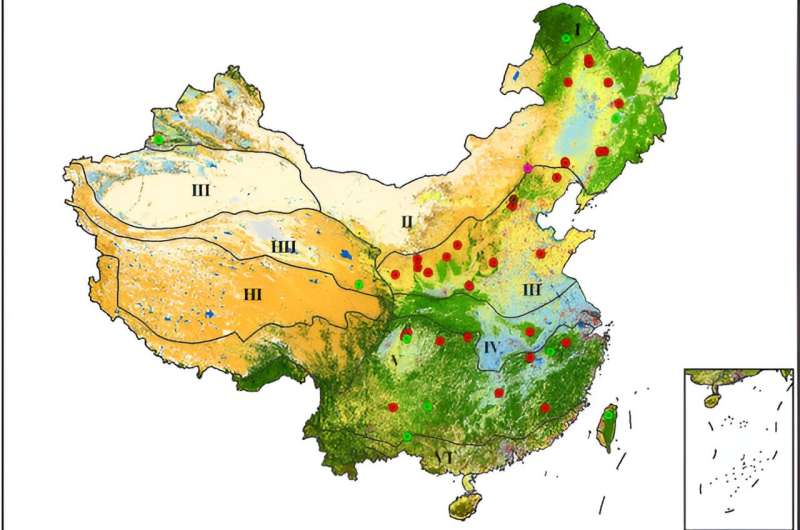China’s leap toward advanced environmental monitoring
For a study published in the Journal of Remote Sensing, a team of scientists led by Xihan Mu from Beijing Normal University has made a leap forward in environmental monitoring and ecological research. They have created seamless maps of Fractional Vegetation Cover (FVC) over China at 30-meter resolution and semimonthly intervals, covering the years 2010-2020.
The researchers adopted an adaptive time-series model for creating clear, seamless, and radiometrically consistent Normalized Difference Vegetation Index (NDVI) image composites using all available Landsat images in Google Earth Engine. Using an improved VI-based mixture model, they have developed a method that transforms Landsat NDVI datasets into a detailed Fractional Vegetation Cover (FVC) map.
This innovation’s heart is the MultiVI algorithm, which precisely calculates pixel-wise coefficients to transform NDVI into FVC. This method marks a major advancement over traditional VI-based mixture models, which typically depend on less accurate, statistically derived endmember VI values.
MultiVI, on the other hand, employs multiangle data to generate pixel-wise endmember VI values, resulting in a more refined and accurate FVC calculation. The researchers validated this approach by comparing the generated FVC with ground measurements and existing global FVC products, demonstrating its good spatial and temporal consistency.
The results underscored the method’s superiority in accurately capturing detailed vegetation patterns and dynamics, surpassing traditional models. This intricate mapping process fosters a more nuanced understanding of the Earth’s vegetation cover and has potential applications in environmental monitoring, agricultural management, and climate change studies.
Dr. Xihan Mu, the lead researcher, said, “This method not only refines the spatial resolution of FVC mapping with good accuracy but also captures the temporal changes in vegetation cover, marking a technological progress in remote sensing and ecological monitoring.”
The 30-m/15-day FVC mapping carries profound implications for various applications, significantly enhancing ecological assessments, crop monitoring, and detailed vegetation analysis—all crucial for understanding and mitigating climate change effects. Additionally, it provides invaluable data for precision agriculture, urban ecosystem research, and soil erosion risk assessments, thereby boosting our capacity to monitor and respond effectively to environmental changes.
This research represents a new advancement in high-resolution vegetation mapping, offering a fresh perspective on Earth’s terrestrial ecosystems. As this method continues to be adopted and refined, it promises to enhance environmental monitoring and management, unlocking new possibilities for a sustainable future.
More information:
Tian Zhao et al, Mapping Spatially Seamless Fractional Vegetation Cover over China at a 30-m Resolution and Semimonthly Intervals in 2010–2020 Based on Google Earth Engine, Journal of Remote Sensing (2023). DOI: 10.34133/remotesensing.0101
Citation:
Progress in high-resolution vegetation mapping: China’s leap toward advanced environmental monitoring (2024, January 15)
retrieved 15 January 2024
from https://phys.org/news/2024-01-high-resolution-vegetation-china-advanced.html
This document is subject to copyright. Apart from any fair dealing for the purpose of private study or research, no
part may be reproduced without the written permission. The content is provided for information purposes only.

For a study published in the Journal of Remote Sensing, a team of scientists led by Xihan Mu from Beijing Normal University has made a leap forward in environmental monitoring and ecological research. They have created seamless maps of Fractional Vegetation Cover (FVC) over China at 30-meter resolution and semimonthly intervals, covering the years 2010-2020.
The researchers adopted an adaptive time-series model for creating clear, seamless, and radiometrically consistent Normalized Difference Vegetation Index (NDVI) image composites using all available Landsat images in Google Earth Engine. Using an improved VI-based mixture model, they have developed a method that transforms Landsat NDVI datasets into a detailed Fractional Vegetation Cover (FVC) map.
This innovation’s heart is the MultiVI algorithm, which precisely calculates pixel-wise coefficients to transform NDVI into FVC. This method marks a major advancement over traditional VI-based mixture models, which typically depend on less accurate, statistically derived endmember VI values.
MultiVI, on the other hand, employs multiangle data to generate pixel-wise endmember VI values, resulting in a more refined and accurate FVC calculation. The researchers validated this approach by comparing the generated FVC with ground measurements and existing global FVC products, demonstrating its good spatial and temporal consistency.
The results underscored the method’s superiority in accurately capturing detailed vegetation patterns and dynamics, surpassing traditional models. This intricate mapping process fosters a more nuanced understanding of the Earth’s vegetation cover and has potential applications in environmental monitoring, agricultural management, and climate change studies.
Dr. Xihan Mu, the lead researcher, said, “This method not only refines the spatial resolution of FVC mapping with good accuracy but also captures the temporal changes in vegetation cover, marking a technological progress in remote sensing and ecological monitoring.”
The 30-m/15-day FVC mapping carries profound implications for various applications, significantly enhancing ecological assessments, crop monitoring, and detailed vegetation analysis—all crucial for understanding and mitigating climate change effects. Additionally, it provides invaluable data for precision agriculture, urban ecosystem research, and soil erosion risk assessments, thereby boosting our capacity to monitor and respond effectively to environmental changes.
This research represents a new advancement in high-resolution vegetation mapping, offering a fresh perspective on Earth’s terrestrial ecosystems. As this method continues to be adopted and refined, it promises to enhance environmental monitoring and management, unlocking new possibilities for a sustainable future.
More information:
Tian Zhao et al, Mapping Spatially Seamless Fractional Vegetation Cover over China at a 30-m Resolution and Semimonthly Intervals in 2010–2020 Based on Google Earth Engine, Journal of Remote Sensing (2023). DOI: 10.34133/remotesensing.0101
Citation:
Progress in high-resolution vegetation mapping: China’s leap toward advanced environmental monitoring (2024, January 15)
retrieved 15 January 2024
from https://phys.org/news/2024-01-high-resolution-vegetation-china-advanced.html
This document is subject to copyright. Apart from any fair dealing for the purpose of private study or research, no
part may be reproduced without the written permission. The content is provided for information purposes only.
